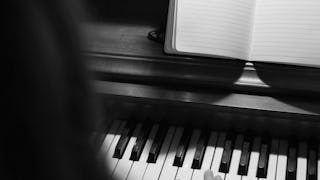The blues is an American art form and the most important musical form in jazz. Although there are other formal paradigms of the blues, such as 8-bar or 16-bar, this course focuses on different incarnations of the 12-bar blues. There are considerable differences between Early Jazz blues, Swing blues, Bebop blues, Modal blues, and Post Bop blues. Each type has its unique harmonic syntax, melodic vocabulary and, associated with them, improvisational techniques. While other aspects of jazz performance practice have been constantly changing from one stylistic convention to another, the blues has never lost its identity and expressive power, and continues to exert a powerful influence on the harmonic and melodic syntax of jazz.



The Blues: Understanding and Performing an American Art Form

Instructor: Dariusz Terefenko
35,200 already enrolled
Included with
(609 reviews)
What you'll learn
Students will be able to describe the blues as an important musical form.
Students will be able to explain differences in jazz and other variations of the blues.
Skills you'll gain
Details to know

Add to your LinkedIn profile
7 assignments
See how employees at top companies are mastering in-demand skills

There are 7 modules in this course
Lesson 1 focuses on foundational aspects of the blues, examining its history, innovation, and evolving harmonic structure. At the end of this lecture, students should have a firm understanding of the harmonic structure of the basic, generic, and minor blues forms, as well as a familiarity with the A A’ B phrase-structure of the blues.
What's included
7 videos1 assignment
Lesson 2 dives into what makes the blues tick, beginning with an examination of the blues scale and the basics of jazz rhythms and blues riffs. Students will then explore call and response techniques and application of the blues scale in improvisation through demonstration with a live musician.
What's included
6 videos1 assignment
Lesson 3 introduces the concept of guide tones and its association with invertible counterpoint. Four-part and five-part chords are discussed in detail by exploring their construction and function, as well as techniques to facilitate good voice-leading between chords using chordal inversions.
What's included
7 videos1 assignment
In lesson 4 students analyze harmonic progressions from 3 jazz standards: “Now’s The Time,” “Billie’s Bounce,” and “Blues For Alice.” Practice techniques are discussed, including ear-training strategies, rhythmic displacement, and voice-leading exercises.
What's included
7 videos1 assignment
Lesson 5 introduces 3 more jazz standards for analysis: “Mr. PC,” “Mr. Day,” and “Isotope.” Tritone substitutions are examined, and pentatonic scale as tools in improvisation are introduced through exploration of their construction, typical voicings, and voice-leading principles.
What's included
8 videos1 assignment
Lesson 6 centers around the demonstration of improvisational techniques discussed thus far, including motivic development, guide-tone lines, and chordal arpeggiation. Observation of live Eastman musicians, as well as play-along tracks provided by the rhythm section, allow the student to imitate, assimilate, and apply the techniques discussed in the course.
What's included
14 videos1 assignment
Lesson 7 explores modal categories and scalar patterns in improvisation, in addition to continued discussion on pentatonics. As in the previous lesson, live musicians demonstrate key concepts and principles presented in the lecture, with additional play-along tracks provided for the student to explore concepts on their own.
What's included
12 videos1 assignment
Instructor

Offered by
Explore more from Music and Art
 Status: Free Trial
Status: Free TrialBerklee
 Status: Free Trial
Status: Free Trial Status: Free Trial
Status: Free TrialBerklee
 Status: Free Trial
Status: Free Trial
Why people choose Coursera for their career




Learner reviews
609 reviews
- 5 stars
86.88%
- 4 stars
10.81%
- 3 stars
1.47%
- 2 stars
0.32%
- 1 star
0.49%
Showing 3 of 609
Reviewed on Oct 26, 2017
Everything is clearly explained and demonstrated. It was great being able to downloads course videos and transcripts for reference.
Reviewed on Feb 25, 2017
A very comprehensive course with clear explanation on the various type of the progressions and scales used in Jazz and Blues music.
Reviewed on Dec 30, 2016
The most interesting and complete course about the blues I've have ever seen! Structured, clear and very kind form of teaching. Thank you, Dariusz!

Open new doors with Coursera Plus
Unlimited access to 10,000+ world-class courses, hands-on projects, and job-ready certificate programs - all included in your subscription
Advance your career with an online degree
Earn a degree from world-class universities - 100% online
Join over 3,400 global companies that choose Coursera for Business
Upskill your employees to excel in the digital economy
Frequently asked questions
To access the course materials, assignments and to earn a Certificate, you will need to purchase the Certificate experience when you enroll in a course. You can try a Free Trial instead, or apply for Financial Aid. The course may offer 'Full Course, No Certificate' instead. This option lets you see all course materials, submit required assessments, and get a final grade. This also means that you will not be able to purchase a Certificate experience.
When you purchase a Certificate you get access to all course materials, including graded assignments. Upon completing the course, your electronic Certificate will be added to your Accomplishments page - from there, you can print your Certificate or add it to your LinkedIn profile.
Yes. In select learning programs, you can apply for financial aid or a scholarship if you can’t afford the enrollment fee. If fin aid or scholarship is available for your learning program selection, you’ll find a link to apply on the description page.
More questions
Financial aid available,

